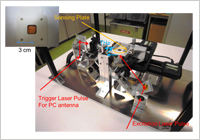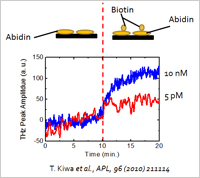Enlarge Image Fig. 2. The detection of abidin – biotin binding using TCM. The red and blue curves represent the detection of the biotin with concentrations of 5 pM and 10 nM,respectively.
Enlarge Image
Unique terahertz chemical microscope for mapping chemical reactions
Imaging systems utilizing terahertz (THz) time-domain spectroscopy (TDS) are attractive for nondestructive testing. However, due to the large absorption of the water in THz frequency, it is not possible to measure the properties of chemicals and/or chemical reactions.
Here, a THz chemical microscope (TCM) is proposed and developed for mapping chemical potentials of chemical reactions in a gaseous atmosphere and aqueous solutions.
The TCM utilizes a sensing plate, which consists of an insulator thin film and a semiconductor thin film on a sapphire substrate. The existence of defects in the semiconductor thin film, results in the generation of local electric fields by energy band bending in the semiconductor layer near the boundary of the insulator and semiconductor layers. When the femto-second laser pulse hits the sensing plate, the THz pulse—whose amplitude is related to the magnitude of the local fields—is generated.
A chemical reaction is measured by dropping the sample solution onto the sensing plate so as to make contact with the insulator surface. If the chemical reaction proceeds and the chemical potential at the surface of the insulator layer shifts, leading to changes in the magnitude of the local field changes. Thus the chemical reaction at exactly where laser shines can be measured as the amplitude of THz pulse.
Fig. 1 shows is a photograph of the prototype TCM system. The excitation laser pulse is introduced into the unit through the pin hole and focused onto the back-side of the sensing plate. The trigger laser pulse is also introduced into the unit to operate the photo-conductive (PC) antenna which is conventionally used to detect the THz pulses.
Applications demonstrated to date include, a high-sensitivity immune-assay (Fig. 2) , measurement of ionic reactions, and redox reactions of enzymes [1-4].
Reference
[1] T. Kiwa et al., JJAP, 46 (2007) pp. L1052-L1054.
[2] T. Kiwa et al., APL, 96 (2010) 211114.
[3] T. Kiwa et al., Sens. Act. B, (2012) 10.1016/j.snb.2012.08.051.
[4] T. Kiwa et al., Opt. Exp., 20 (2012), pp. 11637-11642


